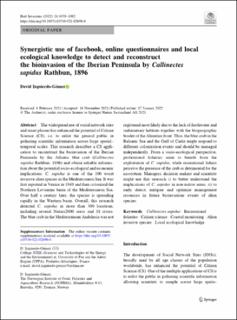| dc.contributor.author | Izquierdo-Gomez, David | |
| dc.date.accessioned | 2023-02-08T13:50:45Z | |
| dc.date.available | 2023-02-08T13:50:45Z | |
| dc.date.created | 2022-05-11T10:03:57Z | |
| dc.date.issued | 2022 | |
| dc.identifier.citation | Biological Invasions. 2022, 24 (4), 1059-1082. | |
| dc.identifier.issn | 1387-3547 | |
| dc.identifier.uri | https://hdl.handle.net/11250/3049385 | |
| dc.description.abstract | The widespread use of social network sites and smart phones has enhanced the potential of Citizen Science (CS), i.e. to enlist the general public in gathering scientific information across large spatial–temporal scales. This research describes a CS application to reconstruct the bioinvasion of the Iberian Peninsula by the Atlantic blue crab (Callinectes sapidus Rathbun, 1896) and obtain reliable information about the potential socio-ecological and economic implications. C. sapidus is one of the 100 worst invasive alien species in the Mediterranean Sea. It was first reported in Venice in 1949 and then colonized the Northern Levantine basin of the Mediterranean Sea. Over half a century later, the species is spreading rapidly in the Western basin. Overall, this research detected C. sapidus in more than 300 locations, including several Natura2000 areas and 18 rivers. The blue crab in the Mediterranean Andalusia was not registered most likely due to the lack of freshwater and sedimentary habitats together with the biogeographic border of the Almerian front. Thus, the blue crab in the Balearic Sea and the Gulf of Cadiz might respond to different colonization events and should be managed independently. From a socio-ecological perspective, professional fisheries seem to benefit from the exploitation of C. sapidus, while recreational fishers perceive the presence of the crab as detrimental for the ecosystem. Managers, decision makers and scientists might use this research i) to better understand the implications of C. sapidus in non-native areas, ii) to early detect, mitigate and optimize management resources in future bioinvasions events of alien species. | |
| dc.language.iso | eng | |
| dc.title | Synergistic use of facebook, online questionnaires and local ecological knowledge to detect and reconstruct the bioinvasion of the Iberian Peninsula by Callinectes sapidus Rathbun, 1896 | |
| dc.title.alternative | Synergistic use of facebook, online questionnaires and local ecological knowledge to detect and reconstruct the bioinvasion of the Iberian Peninsula by Callinectes sapidus Rathbun, 1896 | |
| dc.type | Peer reviewed | |
| dc.type | Journal article | |
| dc.description.version | publishedVersion | |
| dc.source.pagenumber | 1059-1082 | |
| dc.source.volume | 24 | |
| dc.source.journal | Biological Invasions | |
| dc.source.issue | 4 | |
| dc.identifier.doi | 10.1007/s10530-021-02696-0 | |
| dc.identifier.cristin | 2023337 | |
| cristin.ispublished | true | |
| cristin.fulltext | original | |
| cristin.qualitycode | 1 | |
